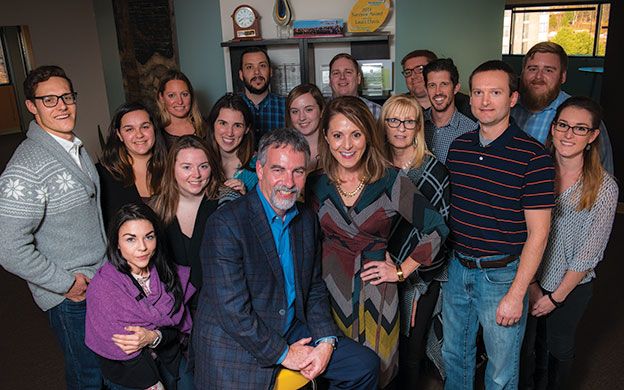Rinck Advertising prepares to make the jump beyond Auburn and the state
 Photo / Russ Dillingham
Rinck Advertising is growing quickly at its Auburn headquarters and is poised to open an office in Annapolis, Md., in part to tap the thriving Baltimore-Washington market. The staff is led by CEO Peter Rinck, front and center, and President Laura Davis, on his left.
Photo / Russ Dillingham
Rinck Advertising is growing quickly at its Auburn headquarters and is poised to open an office in Annapolis, Md., in part to tap the thriving Baltimore-Washington market. The staff is led by CEO Peter Rinck, front and center, and President Laura Davis, on his left.
Rinck Advertising, the full-service advertising, media and public relations agency founded by CEO Peter Rinck and President Laura Davis in 2001, has been growing by leaps and bounds.
For the year, Rinck Advertising anticipates revenue of $8 million to $10 million, compared with $2 million in 2011. The Auburn office has 32 employees. In the past 18 months, the team has grown by 12 people, with five hired within the past month.
Now, the agency is poised to open a branch office Annapolis, Md., in order to grow there and in the Baltimore-Washington corridor.
“We see it as an area of opportunity,” says CEO Peter Rinck. “The initial thinking about this began almost four years ago. In the last two years we've been doing the research — what the local market looks like, what the competition looks like.”
The Annapolis office will be led by Rinck and Davis' daughter, Sarah Bird, and son-in-law, Tony Bird. As the agency's social media manager, Sarah strategizes and creates content across social media platforms. Prior to joining Rinck, she served in the same capacity at The Cyphers Agency in Annapolis, where she strategized, developed and managed content for social media clients; wrote and developed creative briefs; and analyzed social media performance. Tony Bird is an account executive who has worked on all aspects of national ad campaigns, including digital, traditional and video production, and brings an extensive background in digital media, search engine optimization, search engine marketing and marketing strategy.
The Birds are continuing research of the Annapolis market and potential clients and vendors. The office will open Jan. 1, 2016. Three clients are lined up so far, including a small company called Chef Salt, makers of specialty salt and herb mixes.
Rinck and Davis determined their firm's broad range of client service, as well as its experience with consumer packaged goods, financial, transportation, education and health care clients, would be unique to the region. Also standing out, he says, will be the agency's trademarked “Brand Touch” marketing strategy, which integrates experiential consumer promotions, public relations and social media.
Raised in a 'Mad Men' household
Rinck honed his advertising chops early on as the son of Madison Avenue executive Larry Rinck, who lived the life depicted by “Mad Men.” The elder Rinck took a job in 1962 at the Sperry & Hutchinson Co. in New York City, better known as S&H Green Stamps, the giant consumer incentives/awards program. Larry rose to S&H Green Stamps' vice president of advertising, responsible for a $10 million national budget, equivalent to a $76 million ad spend in today's media market.
“He knew all the greats on Madison Avenue. And in many ways he was a great himself,” Peter Rinck says.
Larry Rinck is still at it. He recently joined the firm as “chief inspiration officer.” Larry Rinck's approach to the business wasn't about strategies of a previous era, but about eternal relationship values.
“Dad has had a profound influence on the agency,” says Rinck. “He's 94 and, in many ways, he's always been the Rinck in Rinck Advertising. Dad's inspiration has always been, 'Be open, be honest, be transparent, be fair and do your best work. If you do those things to the best of your ability, people will trust you.' Those lessons have served us well.”
Peter Rinck got into the industry in the late 1970s. His first big job came in 1983 at L.L. Bean, where he was a copywriter for the catalogs and gained expertise in direct-response marketing.
Rinck Advertising was established a month after 9/11. Rinck and Davis considered setting up in New York, but decided against it.
“I said, 'Everyone's trying to get out. We could go there,'” he recalls. But Davis viewed Lewiston/Auburn as an up-and-coming area with plenty of potential. “She was right. It's been great here. The local community immediately treated us well. Local businesses hired us when they didn't have to, just to help us keep our doors open.”
Rinck developed a client list that has included Gorton's Seafood, Dean Foods, American Beverage Corp. and McDonald's, as well as the Amtrak Downeaster, University of Southern Maine, Partnership for a Tobacco-Free Maine, Portland International Jetport and Agren Appliance. Historically, 60% to 80% of its business has been with out-of-state firms, a percentage that remains consistent today, but with a larger roster of clients.
Data-driven marketing
The agency's overall approach is to offer a “tactical mix” that includes branding, television, radio, print, public relations, direct marketing, promotions and proprietary brands: BlogBeat and Listening strategies, and Brand Touch, a registered trademark. BlogBeat taps into Rinck's network of 1,700 influential bloggers to endorse and promote brands. Listening monitors more than 65 million online sources to track real-time conversations and reviews for clients, brands, competitors and industry. Brand Touch seeks to identify and dialogue with subsets of influential consumers to harness their influence for client brands.
Clients receive an integrated approach, driven by data, typically available only from a large agency or network, says Rinck.
These strategies reflect the agency's evolution in today's digital age. Rinck recalls a shift, in the early 1990s, when the Internet was changing both the industry's culture and methods.
“The long, three-martini lunches went out the door,” he says. “We all worked hard and ate lunch at our desk. It was as exciting a time as the invention of radio and the invention of television in earlier eras. It rapidly changed what we did and what we do on a daily basis.”
The “Mad Men” era met creative challenges with mass campaigns conveyed through television and supported by radio, print and direct mail.
“There were only a few tools to choose,” he says. “The Internet changed that. Instead of being a one-way conversation, it was two-way. Consumers had a voice on a granular basis. You mattered as a person. As a result, the nature of the business, and how we think about the business, changed dramatically. We have to pay attention to individuals, not just to an aggregate consumer.”
The business is informed not only by changes in technology, but by up-and-coming generations of clients and staff who are digital natives.
“It's interesting, because they can get so granular, and they're comfortable doing so in the data,” says Rinck. “And we reflect that. At the same time, we provide the big insights.”
From the strategy standpoint, that means market segmentation.
“Not all consumers want the same thing out of products or brands or services,” he says. “So one segmentation might be age demographics. Another might be geo-demographics. A third might be lifestyle demographics. For example, if we take our millennial audience at the upper age, mid-30s, they're having families and starting businesses. They have purchasing power. At the lower end, they're 18 and still in school. The segment could probably be divided 10 different ways. But then, if digital platforms can support segmentation, we have to ask what does a TV commercial or print ad look like? How do we address all of those consumer needs in a broad way on the mass market? It's a challenge — and that's what gets everybody excited. It's a continuous-learning industry, and we are a continuous-learning company.”










Comments